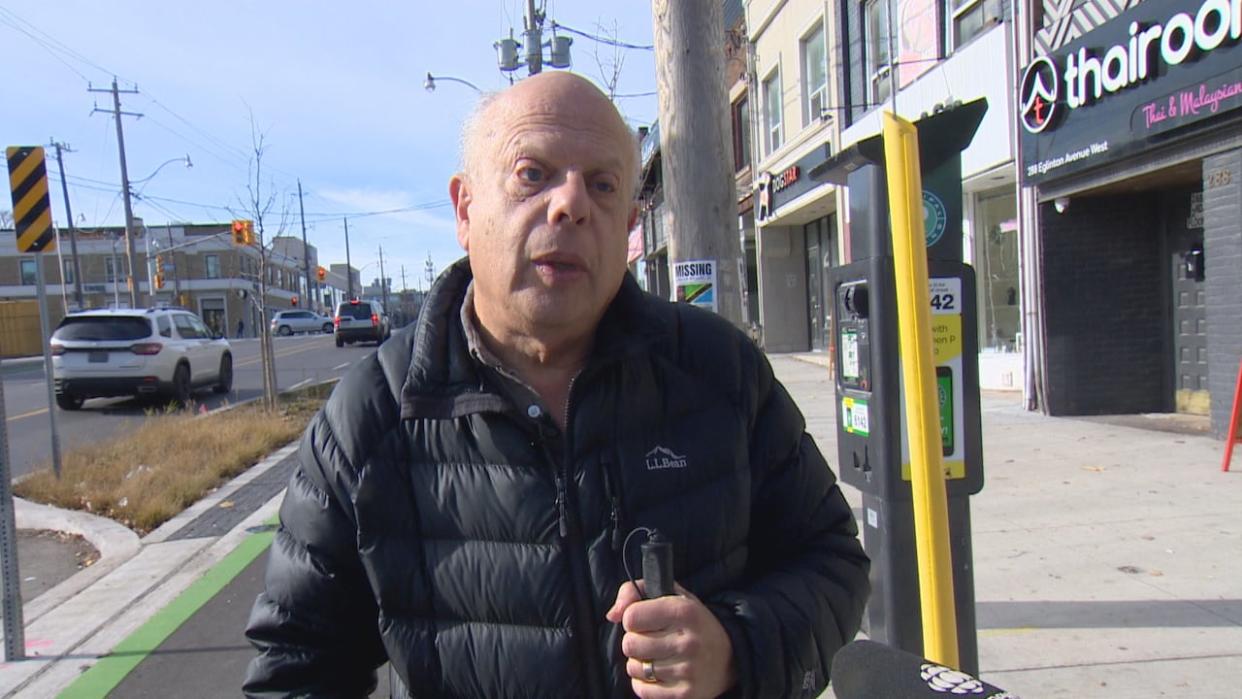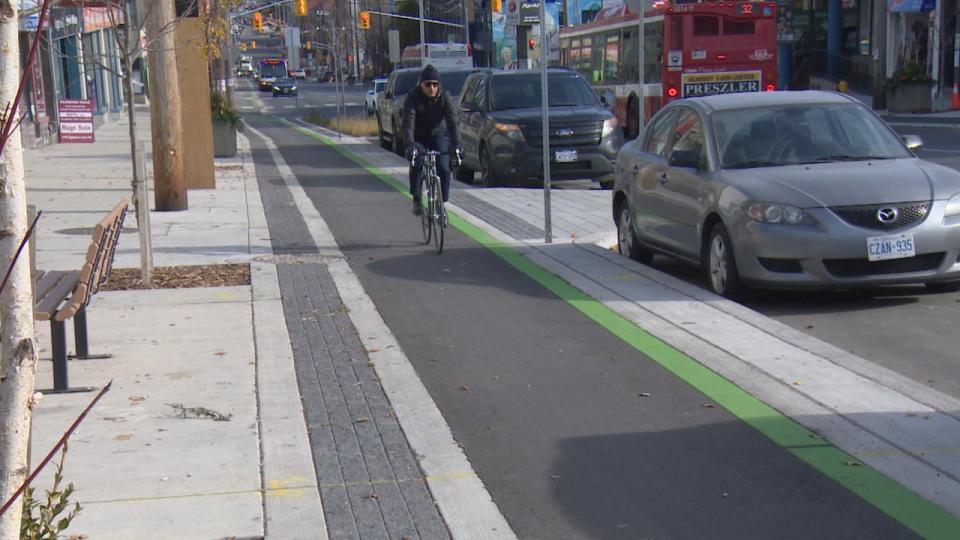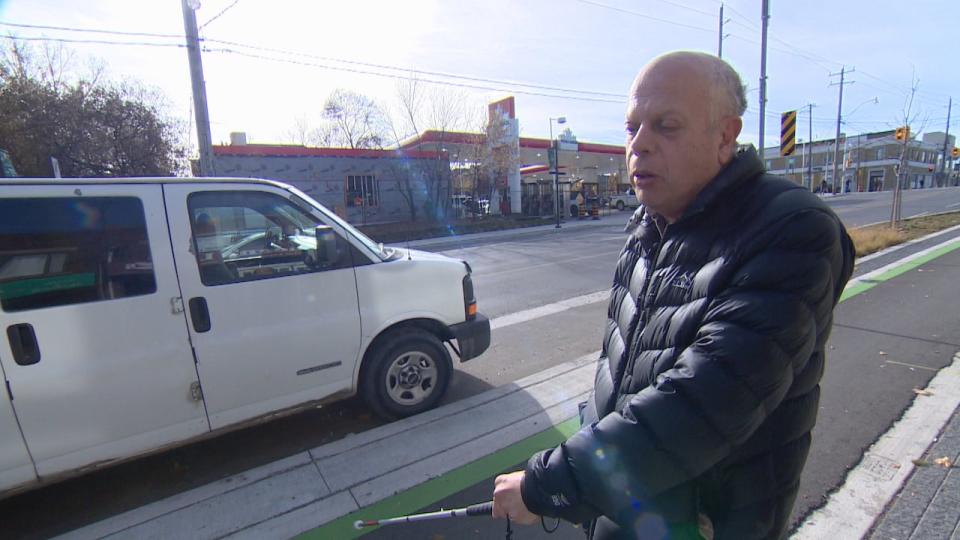Blind advocates say a bike lane design on this Toronto street spells danger

David Lepofsky was shocked to learn he was about to cross from the sidewalk into a bike path during a walk with a friend earlier this month — something he only learned because his sighted friend pointed it out.
A section of bike lane on Eglinton Avenue, beginning east of Avenue Road, is at the same grade as the sidewalk.
"I was shocked," said Lepofsky, who has been completely blind for decades and uses a white cane to navigate the streets of Toronto.
"Then I was disgusted … how on Earth did they do this with such callous disregard for the safety of blind pedestrians?"

A bike lane on Eglinton Avenue puts bikes at the same level as pedestrians, something blind advocates say is a major concern. (Paul Smith/CBC)
He says his friend told him there was a line of dark stone pavement seemingly indicating the transition to the bike lane.
The surface of the bike lane and the sidewalk were different colours from each other — something that's irrelevant to people like Lepofsky, who use a cane to feel out the difference in the ground's texture to get around.
"The texture of the ground of sidewalks in Toronto changes from one metre to the next," said Lepofsky. "There's no reliable pattern. You can't depend on it."
He says even if a change in texture is detected, it doesn't tell people unfamiliar with this marking that it's a path for cyclists.
Lepofsky is calling on the city to make changes to this bike lane immediately, placing it lower than the sidewalk for the safety of all blind pedestrians and cyclists who shouldn't have to worry about hitting pedestrians or their canes.
Bike lane design differs from what was recommended
The City of Toronto told CBC Toronto in an interview it held "accessibility site visits" throughout the city that included people with disabilities and found the type of dark pavers used were detectable by participants.
However, these accessibility visits, among other factors, resulted in a bike lane design different from the one put in place on this section of Eglinton Avenue.
"Our preferred design today is to have the street and then the bikeway to be 50 millimetres above the streets, and then the bikeway to be 50 millimetres below the sidewalk… so everybody's raised," said Becky Katz, manager of cycling and pedestrian projects for the City of Toronto.
In the case of the section of Eglinton described by Lepofsky, she said the street was designed at the same time as the Eglinton Crosstown project — a design over 10 years old. However, she said the bike lane was completed recently.
She says there are several instances throughout the city that use the design of concern to Lepofsky, and more are still occasionally constructed using this design.
'Scares the living daylights out of me', disability advocate
Marcia Yale, National President of the Alliance for Equality of Blind Canadians, who relies on a guide dog to navigate, said having bikes at sidewalk level "scares the living daylights out of me."
In this case, she said the city's handling of bike lane designs endangers both cycling and pedestrian road users if a blind person wanders into the bike lane because they cannot feel or otherwise detect they are no longer on the sidewalk.
"It's like saying we know that seatbelts are really good for you and just deciding not to put them in a car," said Yale. "Why would you use an old design, if you know that there are newer ones?"

Marcia Yale, the National President of the Alliance for Equality of Blind Canadians, says continuing to build outdated designs that don't protect road users with disabilities is problematic. (Submitted by: Marica Yale)
Yale, a longtime Toronto resident who now lives outside of the city, says choices like this erode the confidence of people with limited to no vision when it comes to navigating the city.
"It doesn't encourage me to wander on my own, that's for sure … I don't want to be run into by a bike," she said.
Opportunity to prevent future issues: professor
Ron Buliung, a professor in the department of geography, geomatics and environment at the University of Toronto Mississauga, says sometimes a design element can get trapped in a bureaucratic cycle.
He says this issue is an opportunity for the city to consider if another review of bike lane plans should take place before shovels hit the ground elsewhere.

David Lepofsky says he doesn't wants to see bike lanes on the same level as sidewalks, calling on the city to fix the issue on Eglinton Avenue and anywhere else it has taken place. (Paul Smith/CBC)
"These kinds of design gaffes are very serious … there's a genuine safety risk posed to users of the space," he said.
"The solution is not rocket science … a grade separation or a short curb put in place."
Katz says the city is "always trying to evolve our design and make streets safer and more accessible for all," and welcomes the feedback from those with disabilities who experience the environment differently.
Lepofsky says while he wants to see more bike lanes, this design can't stay.
"They've got to remove it ... we deserve better."


